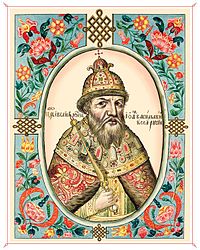
Ivan I Danilovich Kalita was Prince of Moscow from 1325 to at least 1340, and Grand Prince of Vladimir from 1332 until at least 1340.

Dmitry Ivanovich Donskoy was Prince of Moscow from 1359 and Grand Prince of Vladimir from 1363 until his death. He was the heir of Ivan II.

Ivan III Vasilyevich, also known as Ivan the Great, was Grand Prince of Moscow and all Russia from 1462 until his death in 1505. Ivan served as the co-ruler and regent for his blind father Vasily II before he officially ascended the throne.
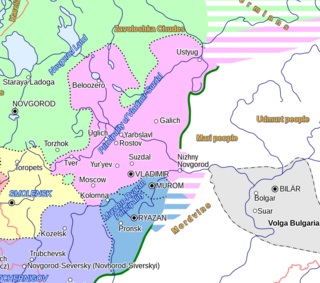
Vladimir-Suzdal, formally known as the Principality of Vladimir-Suzdal or Grand Principality of Vladimir (1157–1331), also as Suzdalia or Vladimir-Suzdalian Rus', was one of the major principalities emerging from Kievan Rus' in the late 12th century, centered in Vladimir-on-Klyazma. With time the principality grew into a grand principality divided into several smaller principalities. After being conquered by the Mongol Empire, the principality became a self-governed state headed by its own nobility. A governorship of the principality, however, was prescribed by a jarlig issued from the Golden Horde to a Rurikid sovereign.
Grand prince or great prince is a title of nobility ranked in honour below Emperor, equal to Archduke, King, Grand duke and Prince-Archbishop; above a Sovereign Prince and Duke.

Monomakh's Cap, also called the Golden Cap, is a chief relic of the Muscovite Grand Princes and Russian Tsars. It is a symbol-crown of the Russian autocracy, and is the oldest of the crowns currently exhibited at the Imperial treasury section of the Kremlin Armoury. Monomakh's Cap is an early 14th-century gold filigree skullcap composed of eight sectors, elaborately ornamented with a scrolled gold overlay, inlaid with precious stones and pearls, and trimmed with sable. The cap is surmounted by a simple gold cross with pearls at each of the extremities.

Vladimir Andreyevich was the last appanage Russian prince. His complicated relationship with his cousin, Ivan the Terrible, was dramatized in Sergei Eisenstein's 1944 film Ivan the Terrible.

Dmitry Mikhailovich, nicknamed the Fearsome Eyes or the Terrible Eyes, was Prince of Tver from 1318 and Grand Prince of Vladimir from 1322 until his death in 1326, when he was executed in Sarai by the Mongols. He was a son of Mikhail of Tver and Anna of Kashin.
The Muscovite–Lithuanian Wars were a series of wars between the Grand Duchy of Lithuania, allied with the Kingdom of Poland, and the Grand Duchy of Moscow, which was later unified with other Russian principalities to eventually become the Tsardom of Russia. After several defeats at the hands of Ivan III and Vasily III, the Lithuanians were increasingly reliant on Polish aid, which eventually became an important factor in the creation of the Polish–Lithuanian Commonwealth. Before the first series of wars in the 15th century, the Grand Duchy of Lithuania controlled vast stretches of Eastern European land, from Kiev to Mozhaysk, following the collapse of Kievan Rus' after the Mongol invasions. Over the course of the wars, particularly in the 16th century, the Muscovites expanded their domain westwards, taking control of many principalities.

The Principality of Ryazan, later known as the Grand Principality of Ryazan, was a principality from 1129 to 1521. Its capital was the city of Ryazan, now known as Old Ryazan, which was destroyed in 1237 during the Mongol invasions. The capital was moved to Pereyaslavl-Ryazansky, later renamed Ryazan.

The Prince of Novgorod was the title of the ruler of Novgorod in present-day Russia. From 1136, it was the title of the figurehead leader of the Novgorod Republic.

The siege of Moscow in 1382 was a battle between the Principality of Moscow and Tokhtamysh, khan of the Golden Horde. In the Battle Tokhtamysh had the Support of Turco-Mongol warlord Timur, with whose help he succeeded.
The Prince of Moscow, later known as the Grand Prince of Moscow, was the title of the ruler of the Principality of Moscow, initially a part of the grand principality of Vladimir-Suzdal. By the late 14th century, the grand principality was inherited by the prince of Moscow; the monarch bore the title of grand prince of Vladimir and Moscow and later the title of grand prince of Vladimir, Moscow and all Russia.
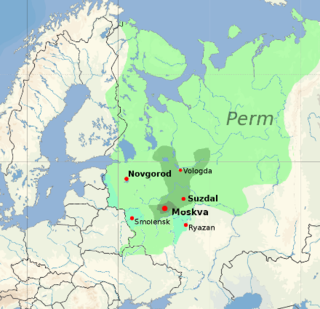
The Principality of Moscow or Grand Duchy of Moscow, also known simply as Muscovy, was a principality of the Late Middle Ages centered on Moscow. It eventually evolved into the Tsardom of Russia in the early modern period. The princes of Moscow were descendants of the first prince Daniel, referred to in modern historiography as the Daniilovichi, a branch of the Rurikids.

Daniil Aleksandrovich, also known as Daniil of Moscow, was the youngest son of Alexander Nevsky and forefather of all Princes of Moscow. His descendants are known as the Daniilovichi.
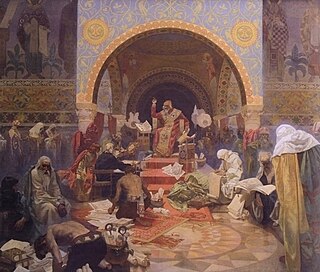
Tsar was a title used by Slavic monarchs. The term is derived from the Latin word caesar, which was intended to mean emperor in the European medieval sense of the term—a ruler with the same rank as a Roman emperor, holding it by the approval of another emperor or a supreme ecclesiastical official —but was usually considered by Western Europeans to be equivalent to "king". It lends its name to a system of government, tsarist autocracy or tsarism.
The Prince of Vladimir, from 1186 Grand Prince of Vladimir, also translated as Grand Duke of Vladimir, was the title of the monarch of Vladimir-Suzdal. The title was passed to the prince of Moscow in 1389.

The Principality of Tver was a principality which existed between the 13th and the 15th centuries with its capital in Tver. It was one of the states established after the decay of the Kievan Rus'. During the 14th century, Tver rivaled the Principality of Moscow with the aim to become the center of the united Russian state. Eventually it lost, decayed, and in 1485, it was annexed by Moscow. The principality was located approximately in the area currently occupied by Tver Oblast and the eastern part of Smolensk Oblast in Russia.
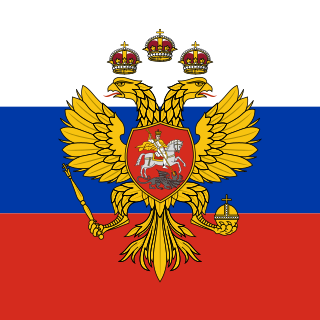
The Tsar of all Russia, officially the Sovereign, Tsar and Grand Prince of all Russia, was the title of the Russian monarch from 1547 to 1721. During this period, the state was a tsardom.

